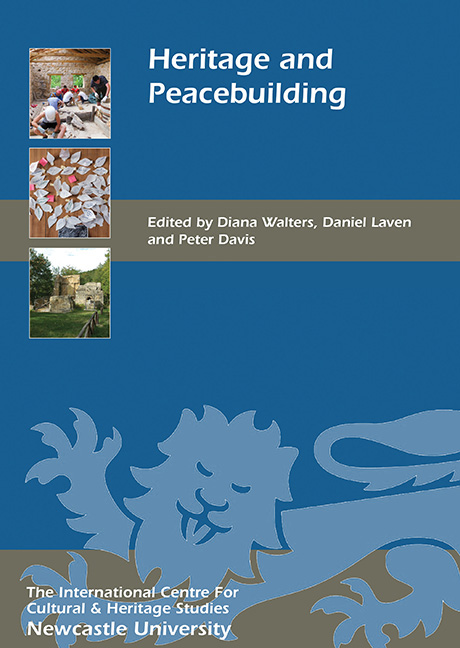Book contents
- Frontmatter
- Contents
- List of illustrations
- Acknowledgements
- List of abbreviations
- Preface
- Introduction
- NEW AND EMERGING IDEAS AROUND HERITAGE AND PEACE
- HERITAGE AND PEACEBUILDING IN PRACTICE
- 7 A Conversation with Sultan Somjee: Conflict and Peacebuilding in Kenya
- 8 Museum, Peace and Reconciliation: the Impact of the Balkan Museum Network
- 9 Diversity, Leadership and Peacebuilding in Museums in the Western Balkans
- 10 Disturbing the Peace: Museums, Democracy and Conflict Avoidance
- 11 Transforming Conflict Through Peace Cultures
- 12 Rethinking Heritage from Peace: Reflections from the Palestinian–Israeli Context
- 13 A Conversation with Will Glendinning: Diversity Challenges in Northern Ireland
- HERITAGE, PEACEBUILDING AND SITES
- List of Contributors
- Index
- Previous Titles
12 - Rethinking Heritage from Peace: Reflections from the Palestinian–Israeli Context
from HERITAGE AND PEACEBUILDING IN PRACTICE
Published online by Cambridge University Press: 16 February 2018
- Frontmatter
- Contents
- List of illustrations
- Acknowledgements
- List of abbreviations
- Preface
- Introduction
- NEW AND EMERGING IDEAS AROUND HERITAGE AND PEACE
- HERITAGE AND PEACEBUILDING IN PRACTICE
- 7 A Conversation with Sultan Somjee: Conflict and Peacebuilding in Kenya
- 8 Museum, Peace and Reconciliation: the Impact of the Balkan Museum Network
- 9 Diversity, Leadership and Peacebuilding in Museums in the Western Balkans
- 10 Disturbing the Peace: Museums, Democracy and Conflict Avoidance
- 11 Transforming Conflict Through Peace Cultures
- 12 Rethinking Heritage from Peace: Reflections from the Palestinian–Israeli Context
- 13 A Conversation with Will Glendinning: Diversity Challenges in Northern Ireland
- HERITAGE, PEACEBUILDING AND SITES
- List of Contributors
- Index
- Previous Titles
Summary
There is inherently no ‘peace’ in heritage, an argument that will be explored in this chapter within the Palestinian–Israeli context. This exploration is a confluence of the professional and personal experiences of the authors, who are active scholars in the field of critical heritage studies. They also have deep roots in the Holy Land, but on either side of the West Bank barrier that separates the West Bank Region of Palestine and the State of Israel.
The contested history of the Holy Land has been well-documented (Barat et al 2015; Pappe 2006; Falah 1996; Said 1992; Masalha 1992; Rouhana 1997), and the authors will not further examine this contested history here. Instead, the authors use their different perspectives on the Palestinian–Israeli problem to uncover the overlooked colonial dimensions of the problem, to understand the role of heritage as a weapon to maintain them and to explore opportunities for heritage to serve a more hopeful purpose in the region.
The Belfour Declaration of 1917 is often viewed as the result of ‘British sympathy’ towards European Jews’ desire to establish their national home. However, little attention is given to British colonial interests in the region and how the British–Zionist alliance sought to reproduce the ‘primitive features of Palestine’ and establish a foundation for the Jewish State of Israel (Pappe 2006; Masalha 1992; Shafir 1996; Lockman 1996). Between 1943 and 1948 Jewish paramilitary groups destroyed and/or forcibly evacuated more than 531 Palestinian villages and 11 urban neighbourhoods, expelled 800,000 Palestinians from their homes and settled Jewish immigrants in these emptied homes (Pappe 2006). This was followed by the unilateral declaration of the establishment of the Jewish State of Israel on 15 May 1948 and the subsequent Arab–Israel War of that year. To the Jews, the result of the war was their political independence and the end of the Diaspora. To the Palestinians this was their Al-Nakba (catastrophe), the destruction of Palestinian society and national identity, the expulsion of the Palestinians from their homes and lands and the beginning of the Palestinian exile.
- Type
- Chapter
- Information
- Heritage and Peacebuilding , pp. 137 - 148Publisher: Boydell & BrewerPrint publication year: 2017



